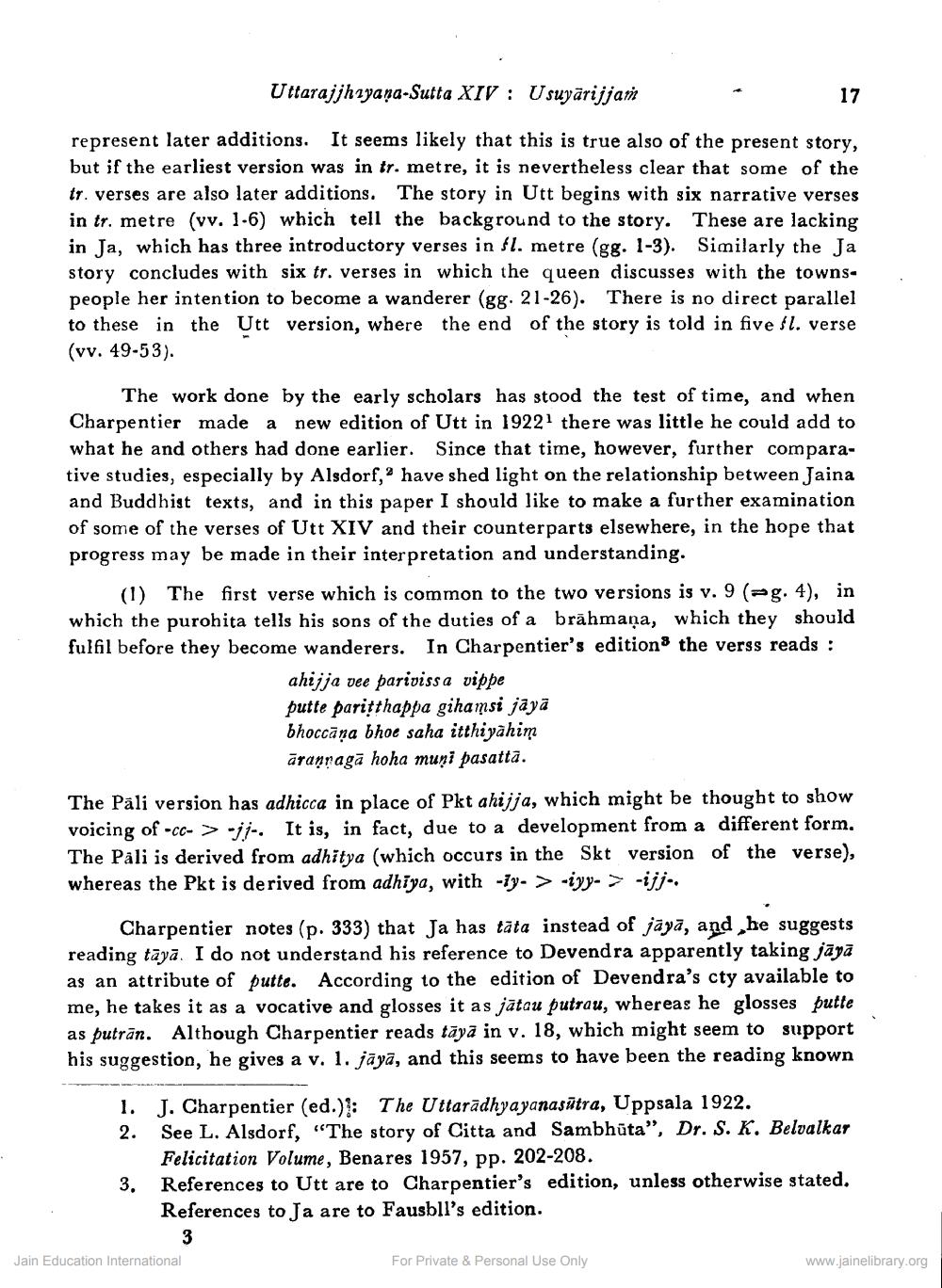Book Title: Uttarajjhayanan Sutra XIV Usuyarjjarah Author(s): K R Norman Publisher: Z_Aspect_of_Jainology_Part_3_Pundit_Dalsukh_Malvaniya_012017.pdf View full book textPage 2
________________ Uttarajjhiyaņa-Sutta XIV : Usuyārijjan 17 represent later additions. It seems likely that this is true also of the present story, but if the earliest version was in tr. metre, it is nevertheless clear that some of the tr. verses are also later additions. The story in Utt begins with six narrative verses in tr. metre (vv. 1-6) which tell the background to the story. These are lacking in Ja, which has three introductory verses in fl. metre (gg. 1-3). Similarly the Ja story concludes with six tr. verses in which the queen discusses with the towns. people her intention to become a wanderer (gg. 21-26). There is no direct parallel to these in the Utt version, where the end of the story is told in five fl. verse (vv. 49-53). The work done by the early scholars has stood the test of time, and when Charpentier made a new edition of Utt in 19221 there was little he could add to what he and others had done earlier. Since that time, however, further comparative studies, especially by Alsdorf, have shed light on the relationship between Jaina and Buddhist texts, and in this paper I should like to make a further examination of some of the verses of Utt XIV and their counterparts elsewhere, in the hope that progress may be made in their interpretation and understanding. (1) The first verse which is common to the two versions is v. 9 (g. 4), in which the purohita tells his sons of the duties of a brāhmaṇa, which they should fulfil before they become wanderers. In Charpentier's editions the verss reads : ahijja vee parivissa vippe putte paritthappa gihamsi jāyā bhoccāņa bhoe saha itthiyahim ārannagā hoha muni pasatta. The Pali version has adhicca in place of Pkt ahijja, which might be thought to show voicing of -cc- > -jj- It is, in fact, due to a development from a different form. The Pali is derived from adhitya (which occurs in the Skt version of the verse), whereas the Pkt is derived from adhiya, with -7y-> -iyy- -ijj.. Charpentier notes (p. 333) that Ja has tāta instead of jāyā, and he suggests reading tāyā. I do not understand his reference to Devendra apparently taking jāyā as an attribute of putte. According to the edition of Devendra's cty available to me, he takes it as a vocative and glosses it as jātau putrau, whereas he glosses putte as putrān. Although Charpentier reads tāyā in v. 18, which might seem to support his suggestion, he gives a v. 1. jāya, and this seems to have been the reading known 1. J. Charpentier (ed.): The Uttarādhyayanasūtra, Uppsala 1922. 2. See L. Alsdorf, “The story of Citta and Sambhūta", Dr. S. K. Belvalkar Felicitation Volume, Benares 1957, pp. 202-208. 3. References to Utt are to Charpentier's edition, unless otherwise stated. References to Ja are to Fausbll's edition. 3 Jain Education International For Private & Personal Use Only www.jainelibrary.orgPage Navigation
1 2 3 4 5 6 7 8 9 10 11
